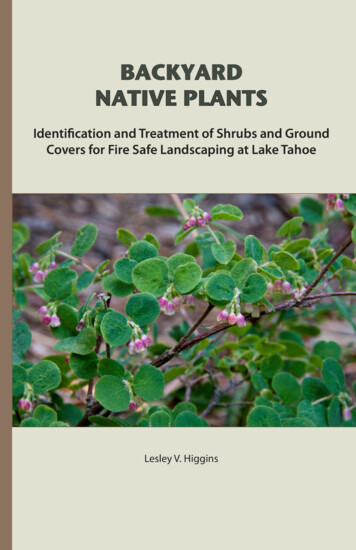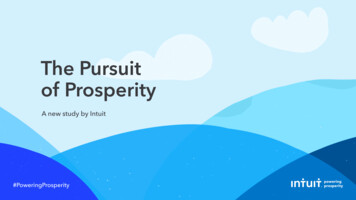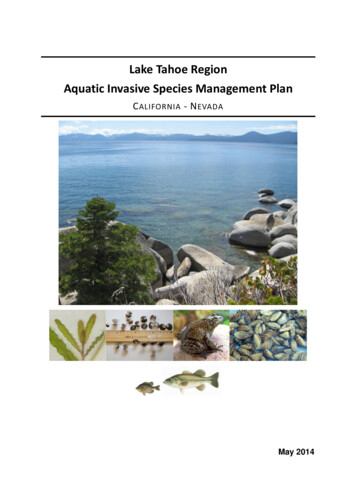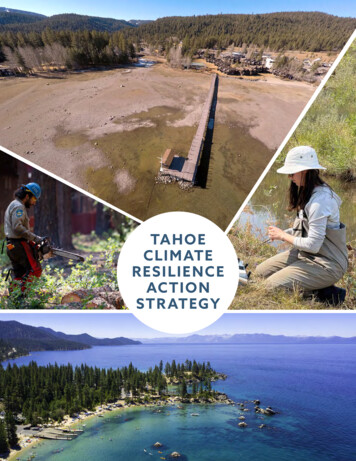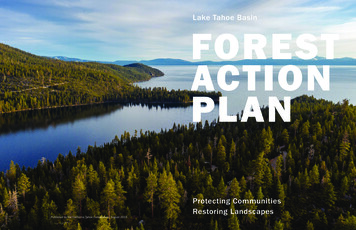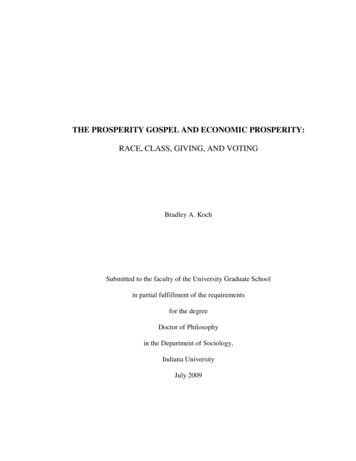
Transcription
June 2022ENVISION TAHOEPROSPERITY PLAYBOOKA SHARED ACTION PLAN FOR ECONOMIC RESILIENCE,INVESTMENT AND COMMUNITY INCLUSIONPhoto credit: Brian Walker PhotographyALERT TAHOECONNECTED TAHOEENVISION TAHOEHOUSING TAHOEWORKFORCE TAHOE
The Envision Tahoe Prosperity PlaybookContentsOpening Letter.3Executive Summary.4About Envision Tahoe .5What is it?Who is involved?More than a simple health examWhat are the desired outcomes?Exhibit 1: The 12-month planning and action process underlying Envision TahoeWhat research has been done?Foreword.10Why economic diversification matters for long-term resilienceExhibit 2: Disruption is becoming more severe and frequentThe past is no longer a predictor of the future“Getting different” means fostering diversity and a range of economic alternativesExhibit 3: Four critical shifts required to make resilience real in Lake TahoeExhibit 4: The average median annual earnings in the Tahoe basin were 53,165 in 2020Looking around to look aheadExhibit 5: Mountain Economy ContinuumTahoe’s commanding advantages; why a mountain economy comparison falls shortThe Envision Tahoe Prosperity Playbook.19Action assessmentExhibit 5: Theory of Change ModelGoal 1: Strengthen key industriesGoal 2: Build skill pathways for upward mobilityGoal 3: Jump start the innovation ecosystemGoal 4: Shape the enabling environmentGetting Tactical: Economic FoundationsAccelerating workforce housing – a whitepaperExhibit 6: Strategies being pursued to improve housing access and affordabilityImproving mobility – An assessment of current plansGetting Tactical: Diversification, Inclusion and Resilience StrategiesTahoe, Inc. (Supporting business start-ups and innovation)Supporting business vitality and diversificationResponsible Tourism (Supporting destination stewardship)Total Plan Investment.70Telling the Tahoe-Truckee Story.71Ongoing Governance and Mutual Accountability.73Systemic steps for maintaining accountabilityFurther tactical plan and partnership engagement neededSuggested key indicators for Envision TahoeWhat’s Next.77Contributions and Sponsors.78Appendix .80 Tahoe Prosperity Center. All rights reserved. No part of this publication may be reproduced or transmitted in any formor by any means, including photocopying and recording, or by any information storage or retrieval system, without theexpressed permission of the Tahoe Prosperity Center.2
MESSAGE FROM THECO-CHAIRSTo our Tahoe -Truckee community –First and foremost, we want to thank you for your dedication to thisregion. We moved here years apart and on different shores, but forthe same reasons as most of you: the mountain lifestyle, communityand opportunity. It is a true pleasure to be able to live and work in aplace like this. We are working hard for a future where local workerscan be full-time residents and help build an even stronger sense ofcommunity. A future where there is housing available for our employeesand their families. A future where our community can be resilient andprosperous because we’re all able to live, work, play and thrive!Ms. Cindy GustafsonCounty SupervisorPlacer CountyEnvision Tahoe Co-Chair“It is only the thingsthat people arepassionate about thatare going to happen”- Chris McNamaraMr. Chris McNamaraFounder and Editor in ChiefOutdoorGearLabEnvision Tahoe Co-ChairPicture a future where roads are less congested and better maintained,transit is accessible for visitors and locals, and connected trailnetworks give people alternate routes to their destinations. Residentsand tourists alike have a shared sense of duty to be Tahoe’sguardians and stewards. A place where businesses would have theopportunity to be innovative and take risks, helping Tahoe develop areputation for cutting-edge research, industry, and climate resiliencework. We are looking to a future with a balanced and resilienteconomy that would allow businesses and institutions to thrive.Today, we are excited to present the Envision Tahoe ProsperityPlaybook, which describes in detail how we can make this future realfor the Tahoe-Truckee Region. This third and final report was createdvia a community-wide commitment to bring this new vision to life. Asvolunteers who love this region and call it home, we were joined by apassionate group of public and private sector leaders who understandthe power that comes from common purpose and a commitment toaction. We engaged a diverse group of Tahoe’s stakeholders to build aplaybook of data-informed strategies aimed at diversifying the region’seconomy, embracing tourism, AND supporting next economy sectorswell suited for this area.In the end, we knew we would position ourselves for success if we couldgenerate a shared vision capable of guiding future investment choices,supportive policy, and local action. It will take energy, investment, andlong-term commitment, but working together as a region, it’s possible.Generations to come are counting on us. Please join us.Sincerely,Cindy and Chris3
EXECUTIVESUMMARYDiversifying the economic base hasbeen discussed for decades. In thewake of COVID-19 and the devastatingimpacts of the Caldor Fire, the time foraction is now. Envision Tahoe showshow.This past year of investigation, in-depthresearch, extensive public engagement,analysis and planning has become thefoundation for improved understandingand stepped-up collaboration andlocal activism to bring about a healthy,inclusive, and sustainable future.The Envision Tahoe Prosperity Playbookis a set of research-based strategiesand tactics (or “plays”) that leaders andresidents in the Tahoe-Truckee Regioncan activate based on subregionalneeds, capacity, and funding. Leadersfrom the public, private, and communitysectors can collaborate and coordinatetheir activities as a cohesive teamworking to achieve a common visionwhile granting members the flexibility toseize emerging opportunities or adjustto changing environments.The Prosperity Playbook includes twofoundational strategies (acceleratingworkforce housing and increasingmobility) and three strategies to energizeand diversify the business sector inorder to build pathways to house-buyingjobs. All include specific and actionablesteps that can lead to execution andresults.Why Inclusive Growth MattersInclusive economic growth is good for both peopleand place. Research shows that regions with lessinequality grow more sustainably over time. Theyoptimize assets, are more efficient and productive,and reduce the business and societal cost of poverty.To learn more, check out the pioneering researchdone by USC Professor Manuel Pastor and UC Davis/ UC Santa Cruz Professor Chris Benner at www.justgrowth.org4Photo by Visit Truckee Tahoe
ABOUTENVISION TAHOEStanding on Tahoe’s beautiful shores,gazing up at the gold-tinged cloudsbuilding under the afternoon sun, youknow instantly this is a one-of-a-kind,sacred place. Granite tipped peaks, thesmell of tall pines in the wind, and crystalclear waters sweep you away. You can beforgiven if you don’t give thought to thelargely invisible local economy that pulsesbeneath.Rightfully, the decades-long obsessionfor Tahoe lovers has been to protectand preserve the unique environmentof the largest and clearest alpine lakein North America after a hodge-podgebuild-up following World War II. KeepTahoe Blue is not just etched on bumperstickers, but codified in strict land useguidelines, activated by powerful andunique planning and regulatory entitieslike the Tahoe Regional Planning Agency(TRPA), and implanted in our minds asa policy imperative, all with admirableresults. Tahoe’s natural beauty fills us,and the resulting actions (and often nonactions) taken to protect this one-of-akind environment over the past decadeshave largely served as Tahoe’s de factoeconomic strategy, as well.Yet the devastating impacts of COVID-19and the Caldor Fire exposed underlyingweaknesses and vulnerabilities that majordisruptions inflict on a mountain economyheavily dependent on tourism. Millionsin financial losses, shuttered businesses,lost jobs, and families pressed to moveout are just some of the consequences.These events have led many leaders totake a closer examination of Tahoe’seconomy and how it has changed overthe past few decades, stricken by climatechange, rocked by skyrocketing costs,and transformed by development andtechnology. Tahoe’s economy – a 5billion annual economy that employstens of thousands and provides the taxbase for essential services we rely uponlike police and fire, schools, and roadmaintenance – is being pulled from thebackground to center stage with a closeexamination of its health. That’s whereEnvision Tahoe comes in.What is it?Envision Tahoe is a 12-month economicinitiative organized and led by the TahoeProsperity Center (TPC), guided by adiverse and regionally representativesteering committee, and underwrittenby the U.S. Economic DevelopmentAdministration as a COVID-19 responseto create an economic recovery andresiliency strategy for the Tahoe Basinemphasizing economic diversification.5
Who’s involved?More than just Tahoe’s leaders, EnvisionTahoe involved nearly 1,800 localresidents in one of the largest regionalpublic opinion surveys ever conducted inthe Tahoe-Truckee area in January, 2022(see Appendix). The Envision Tahoe teamalso conducted dozens of stakeholderinterviews, four geographically dispersedfocus group sessions, and three expertpanels on housing, transportation, andMore than a SimpleEconomic Health ExamThe local agencies and individuals behindEnvision Tahoe were not content to justbuild a better understanding of Tahoe’seconomic vital signs. Just as importantly,they also wanted to create widespreadcommunity engagement and agreementon a new long-term economic vision forthe Tahoe-Truckee Region where onehad never existed before; to activate aset of interlocking tactical work plansinformed by data, prominent experts, andlocal residents; and to be implementedby existing organizations armed with newknowledge and stepped-up resources.At its core, the Envision Tahoe ProsperityPlaybook functions as an inclusiveeconomic strategy intended to benefit allpeople.A snapshot of many of the local leaders from business, government,education, environmental, nonprofit and community groups who have giventheir time and expertise to guide the Envision Tahoe investigation and workproduct. These leaders renamed their group the “Catalyst Committee” toreflect their ongoing commitment after this initial planning phase of EnvisionTahoe to continue to catalyze conversation and action for a resilient andsustainable economy.Envision Tahoe is built on a core set ofbeliefs and values, the primary ones being:The health of the environment andthe health of the economy arecodependent on the health of thecommunity. Each must be planned forand considered jointly.Lake Tahoe should double-down onits leadership position in sustainabledevelopment practices, servingas a test bed in the transition to aninnovative, low carbon future.broadband to inform the findings andconsiderations issued in this third andfinal report: the Envision Tahoe ProsperityPlaybook.Economic inclusion is vital forboth the economy and society. It isessential to broadly held prosperity,upward mobility, individual agency,and improved business and economicresults.6
Interventions must be consideredas an integrated whole, rather thanindependent domains. Activities anddecisions in one domain necessarilyimpact the rest of the system. Piecemeal solutions don’t create durablechange.Viewed as a system, concertedactions will lead to multi-benefitsolutions. For example, increasingaccess to workforce housing willimprove the local labor market for hiring,increase employee retention, shrink longcommutes and the traffic congestion itcan cause, improve public safety, andreduce the health and environmentalimpacts of commuter traffic, amongother benefits.Collective action will deliver betterresults. The Tahoe-Truckee Region issplit across two states and a multitudeof government jurisdictions and its towncenters are geographically remote.Region-wide planning and investmentis essential in order to identify andmake critical shifts in major systems likehousing, transportation, and broadband,but changes are best championed bylocal organizations possessing the talentand capabilities to deliver them. “Planand partner regionally, but executelocally” is our mantra.Taken together, Envision Tahoe is bringingto life the fact that there are no bystanderswhen it comes to the health of Tahoe’seconomy. It is everyone’s job – whetherin government, business, or community.Daily choices and decisions influence thefate of Tahoe’s ecology and economy, andwe all have a stake.What are the desiredoutcomes?The answer falls into two categories:The existence for the first time of abroadly adopted long-term economicresilience and growth strategy for theTahoe-Truckee Region based on a solidunderstanding of:The Tahoe-Truckee Region’s economicstrengths and competitive advantagesLarger market forces and trendsBarriers to economic diversification andgrowthPast and current state of the economyThe transitions necessary to reach acarbon neutral economyShifting demographicsAuthentic resident inputAND a set of investment priorities drivenby:Data and evidencePriorities identified by local stakeholdersA focus on regional and individualprosperityFoundational supports for an inclusiveeconomy (e.g., housing, transportation,digital connectivity, business supports)Industry focused supports emphasizingvisitor-serving activities, health andwellness, and environmental innovation7
Photo by Sugar Pine VillageExhibit 1: The 12-month planning and action process underlying Envision Tahoe.Envision TahoeLake Tahoe Basin Prosperity Plan 2.0May to August 2021ORGANIZING & BUILDINGMOMENTUM Build infrastructure forEnvision Tahoe Design phases Recruit local stakeholders toserve on steering committee Research plan developed anddata gatheringSeptember to JanuaryJanuary to MayRESEARCH AND DISCOVERYDEVELOPING STRATEGIES Economic data synthesisand analysis Development of key strategiesbased on data and withconsensus of leaders U.S. Census info Key informant interviews 3 Expert panels 4 Focus groups Large opinion poll Catalyst Committeemember guidanceWhat research has beendone?This Prosperity Playbook builds on the twoearlier Envision Tahoe reports.The Tahoe Basin Baseline Report,published in September 2021, utilizedthe economic analysis and clusterfocused research conducted by AppliedDevelopment Economics (ADE) in2010 and updated in 2015 and 201718 for the Tahoe Prosperity Center asfoundation. Additionally, Envision Tahoebuilds upon the Economic Forecasting Tactical workplans withspecific and measurableoutcomes created withstakeholders Operational sustainabilitybuilt in Investment priorities madeclearJune onwardEXECUTING ANDREPORTING PROGRESS Growing regional buy-inand ownership of actions Delivery of tactical work plansand overall agenda Identify and align policy andfunding to support priorityactions Ensure accountability andperformance reporting Renew strategies in face ofchanging environmentand Resilience Analysis completed byBeacon Economics in August 2020 todiscern the early economic impactsof the pandemic. New updates to thisoriginal research were then generated byTPC and its consultant firm IntegratedCommunications Strategies (ICS) usinglabor market data, job postings, skillsand profile analytics, compensationdata, and government informationsources derived from EMSI, a U.S.-basedmarket data company. Insights werealso generated from the U.S. Census’sAmerican Community Survey and frompublished reports from local and regionalbusiness and industry trade groups.8
The Community Report, issued inFebruary 2022, built upon the socioeconomic findings of the Baseline Report,and added new data and insights fromthe recently released 2020 Census,the American Community Survey, andfrom published reports from local andregional business and industry tradegroups. In addition, between January 5and January 31, 2022, an online surveywas fielded to generate a statisticallysignificant, quantitative measurementof perspectives on what residents loveabout the Tahoe Basin, what’s threateningthe quality of life in the Basin, andwhere resources should be invested toimprove or maintain quality of life. Localorganizations, news outlets, and theTahoe Prosperity Center promoted thesurvey via their own channels and onsocial media, generating 1,799 surveyresponses. In addition to observationsregarding threats and opportunitiesin the region, the survey captureddemographic data about the surveyrespondents (e.g., place of residence,homeownership, education, income levels,and ethnicity) to learn whether responsesare statistically distinguishable amongdifferent demographic groups or amongcommunities around the Lake.You can find all three of the EnvisionTahoe publications at www.tahoeprosperity.org/envision-tahoe.Special note: The economic, social, andenvironmental impacts of the pandemicupon the people and institutions inthe Tahoe-Truckee Region have beenstrongly felt, but are not yet fullyreflected in government statistics anddata reports at the time the CommunityReport was completed in the winterof 2021. Data references in this reportare for the most current data availableto the research team. This data lag willrequire future investigation, incorporationand analysis as progress is made todiversify Tahoe’s jobs and business mixfor long-term recovery and resiliency.9Photo by: North Tahoe Business Association
FOREWARDWhy economic diversification matters forlong-term resilienceThe world is undergoing increasingly rapid and unprecedented changes. Catastrophicevents are anticipated to be more frequent, more severe, and less predictable goingforward. Our daily experience today is marked by a lingering pandemic, geopoliticaluncertainty, hyper partisanship, rising inflation, climate change, rapid changes intechnology, and more pronounced cultural divisions. This era of turbulence is predictedto impact global and local economic performance for the next decade.Exhibit 2: Disruption is becoming more severe and frequent.19802020Frequency of natural disastersis rising19802020Forest fire counts are rising19802020Geopolitical risk has not beenhigher since 2003155K019802020Frequency of disease outbreaksis rising125K19802020The massive economic shockcaused by COVID-19U.S. Inflation Rate140-21980202019802020Inflation has hit 40-year high(2022 8.5%)Share of Pre-Tax Income0Wet0Dry-819802020Wet and dry periods morefrequent6Real GDP Growth, YOY600Outbreaks Per YearGeopolitical Risk Index0Average DoughtSerenity Index0600Total Employment8120,000Climate ChangeIndicators: WildfiresNatural DisastersPer Year1,000-619802020Pace and severity of economicvolatility rising22%10%1980Top 1%2020Bottom 50%Economic disparity is rising10
Wildfires, droughts, pandemics,recessions and their local impacts havebeen a wake-up call for leaders in theTahoe Region. To thrive in the comingdecade, cities and regions must developresilience (the ability to withstandeconomic, ecological, and social shocks1and disruptions2) and emerge from themhaving mitigated damage and evenstronger than before.That past is no longer apredictor of the futureTen or more years ago, cities and regionshad the luxury of thinking their economicadvantages and industry mix were moreor less stable and would remain so,regardless of the prevailing conditions.Companies and local economies wouldremain strong and continue to grow ifthey consistently became more efficient,reduced costs, increased speed, andfound new markets. Optimization wasthe name of the game. Basic economiccompetition would root out the weakperformers and reward new marketentrants to keep the economy revitalized.Growth was predictable, profitability wasfairly reliable, and jobs were plentiful. Thissteady economic growth model has beenoverridden by shocks and disruptionshappening at global, national, and locallevels that represent a new pattern ofextended turbulence.12Today, in an ever-shifting operatingenvironment, leaders who assume thelocal economy will take care of itself orwho rely on policies and investmentspremised on old data and assumptionswill embed failure into their organizationsand their network partnerships. Theseareas will always lag behind economiccycles, sometimes lagging behind multipleeconomic cycles. In the face of thesegrowing forces, successful cities andregions, just like successful employers,are choosing to withstand the comingupheavals by planning ahead in order tobuild in lasting competitive advantage.Photo by Sugar Pine VillageWe define a “shock” as a sudden event or experience that upsets the status quo. Examples include natural disasters or immediate politicalor community response to an event, activity, or process.We define “disruption” as being less immediate than a shock, representing a substantial break or interruption in the normal course ofactivities over time. Examples include interruptions in natural systems (e.g., climate change, drought) and man-made systems (e.g.,technology, financial markets, or government policy)11
Fostering diversity anda range of economicalternatives is requiredEconomic diversification is a core conceptin economic development circles inwhich a city or region enacts strategies,makes investments, and builds newpartnerships to broaden its economicbase so risk is reduced and so employers,their workforce, and local tax revenuesare more resilient when disruptionoccurs. Economic diversification isequally important to residents, offering awider range of economic opportunitiesfor upward mobility, wage and benefitgains, and improved quality of life. Amore diverse local economy can also bemore adept at solving a communities’problems by offering a mix of approaches,people, and technologies to solveproblems differently and, potentially, moreeffectively.Large and small firms have beenintegrating resilience strategies intotheir operations since the early 2000s toovercome disruptions caused by rapidchanges in technology, external events,and the rise of competition from insideand outside their core industry.3 In fact,resilience planning has received immensefocus in the c-suite over the last two yearsas employers have sought to safeguardtheir supply chains from the shock dueto COVID-19, and recently the RussiaUkraine war. From this growing body ofresilience practice, evidence shows thateconomic diversification at a regionalscale requires a systemic approach thatinvokes a wide array of interventionsranging from entrepreneurship andinnovation, education and workforcetraining, to health and social protections,infrastructure for housing, transportationand communication, as well as resourceconservation and ecological preservation.Enacting resilience and economicdiversification also requires a changein mindset, in strategy, and in choicemaking.Photo of South Lake Brewery3Gary Hamel and Liisa Valikangas, The Quest for Resilience. Harvard Business Review, September 2003.12
Exhibit 3: Four critical shifts required to make resilience real in Lake TahoeModes of the PastMindset shiftStrategy shiftPolitical shiftResource shiftNostalgia for what was. Belief thatpast evidence, decisions, policiesare sacred and can be relied uponto meet the challenges of today’sturbulent operating environment.Rely on the status quo. Perpetuatepast practices and policies. Insulatethe enterprise in old customs andnorms. Only engage the usualsuspects.Stick to siloes. Operate based onscarcity and political interests. Relentto pressure to conform.Leave resource flows on auto pilot.If changes are made, they areincremental.Desired Future StateContinuous reinvention. Adaptation.Flexibility. Appreciate what’s changing.Be willing to consider new approachesand options based on best availabledata.Value diversity and variety. Cultivatemany options and solutions.Experiment. Embrace trial and error.Include more voices, input and diverseopinions. Broaden the ways thecommunity can engage.Create joint ventures. Team up withnatural allies to create political scaleand influence. Ask for more. Challengedoctrine. Re-prioritize where resourcesshould be allocated based on long-termneed.Divert resources from yesterday’sprograms and policies to tomorrow’s.Create a portfolio of options. Investin small trials for rapid learning andscaling, then go big.NOTE: this resilient leadership model is built upon the work of Gary Hamel and Liisa Valikangas;The Quest for Resilience. Harvard Business Review, September 2003.Tourism is highly susceptible to disruptionThe pandemic, the first of its scale in a new era of global travel and interconnectedness,led to a collapse in international and domestic travel. Governments placed limits ontravel and individuals adopted social distancing measures, putting in jeopardy 100 to120 million visitor-related jobs, according to data collected by the United Nations WorldTourism Organization. In California, according to Tourism Economics, leisure traveldropped 47.1% between 2019 and 2020 and is not forecasted to reach pre-COVID-19levels until 2023-24. Similarly, the State of Nevada saw a 54.7% decline in visitationfrom March 2019 to March 2020, and isn’t expected to fully rebound for several years.4Tourism in Tahoe was also negatively impacted by a string of catastrophic fire eventsthat have limited travel access and produced dangerous amounts of smoke. Accordingto the California Department of Forestry and Fire Protection, the five largest wildfiresrecorded in California have all burned in the last five years, and Tahoe has been directlyor indirectly affected by each of them, punctuated by the calamity of the Caldor firewhich surrounded South Lake Tahoe.4Source: Nevada Industry Partners. First Quarter 2020 Fact Sheet.“Discretionaryspending fuelstourism-basedeconomies, sothese economiesare highlysusceptible toeconomic shocks.”– Beacon Economic Forecastingand Resiliency Analysis for Tahoe,August 202013
Average wages aren’t close to homebuying wages in TahoeThe average median annual earnings in the Tahoe Regionfor 2020 was 53,165, according to data compiled by EMSI.Using the three-times-gross-income calculation, a personearning the median income in the region could afford a 159,495 home or condo; a couple making this amountcould afford a 318,990 home or condo in or around theregion. At present, there are no home or condo listings inthe Tahoe Basin at this price point based on recent searchesusing the real estate listing websites Zillow, Redfin, orRealtor.Com, the most visited home and rental listingswebsites in the U.S. See Exhibit 4 for details.Photo by Brian Walker PhotographyExhibit 4: The average median annual earnings in the Tahoe Basin were 53,165 in 2020.TierTopMiddleLowerSource: EMSI, 2022DescriptionAmountHealthcare Practitioners and Technical Occupations 98,793.64Legal Occupations 98,666.80Management Occupations 87,721.41Architecture and Engineering Occupations 84,891.40Computer and Mathematical Occupations 84,729.69Life, Physical, and Social Science Occupations 73,801.45Community and Social Service Occupations 54,506.19MEDIAN WAGE IN TAHOE 53,165.49Educational Instruction and Library Occupations 52,095.66Installation, Maintenance, and Repair Occupations 51,007.87Construction and Extraction Occupations 50,025.03Protective Service Occupations 48,433.27Arts, Design, Entertainment, Sports, and Media Occupations 44,981.32Office and Administrative Support Occupations 39,257.92Production Occupations 38,109.77Transportation and Material Moving Occupations 34,635.24Healthcare Support Occupations 34,422.84Sales and Related Occupations 32,674.43Building and Grounds Cleaning and Maintenance Occupations 32,422.27Personal Care and Service Occupations 29,680.60Food Preparation and Serving Related Occupations 28,003.09Military-only occupations 27,564.21Farming, Fishing, and Forestry Occupations 26,413.4614
Looking around tolook aheadThe Envision Tahoe team examined thecomposition and health of mountainresort economies in the western U.S.that are commonly grouped with Tahoe(see sidebar). Using economic and laborforce data from Economic ModelingSpecialists International (EMSI) andreports and analysis provided by theMilken Institute, the Brookings Institute,as well as economic developmentorganizations and local governmentsources in these communities, apattern emerges of where the TahoeTruckee Region falls in the spectrumof these mountain resort communities– and stands apart from them.Mountain Resort Communitiesgrouped with the TahoeTruckee Region, as defined asbeing at high elevation withpredominantly recreation andvisitor-focused economic bases.Aspen
Exhibit 3: Four critical shifts required to make resilience real in Lake Tahoe Exhibit 4: The average median annual earnings in the Tahoe basin were 53,165 in 2020 Looking around to look ahead Exhibit 5: Mountain Economy Continuum Tahoe's commanding advantages; why a mountain economy comparison falls short

